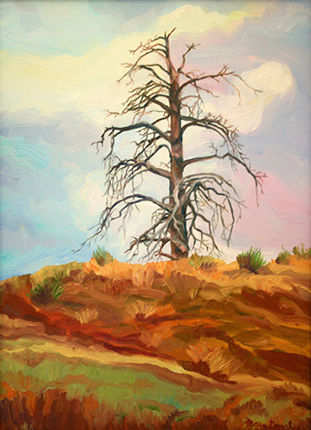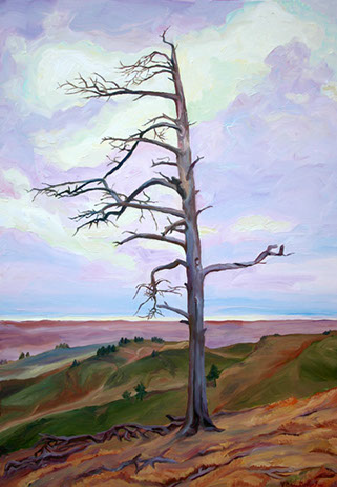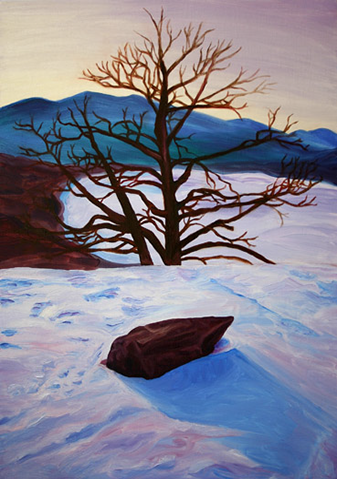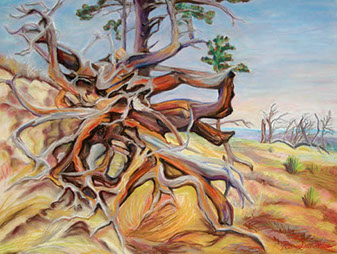Write What You See
by Mary P. Donahue
guest post on Writing Wyoming blog, Aug. 2, 2016
“Draw what you see. Not what you know. “
This is what I say to beginning art students when we are drawing or painting from life. I am a visual artist, designer, and college art professor by education and career but I have often found myself writing as well. In writing, one hears what might be considered the opposite advice—“Write what you know.” When I posed this quandary to Dr. Kathy Bahr, a writing partner and retired English professor, she immediately saw these statements as similar. However, she found the word “know” to be restrictive because one could still write authentically about situations they did not experience firsthand. My eyebrows furrowed. I am going to have to figure this out.
Bret Anthony Johnston in his essay, “Don’t Write What You Know,” in The Atlantic, (though he does not heed his own title advice and goes on to give examples of writers writing what they know) mentions the possibility of this cliché originating with Hemingway and becoming altered in the repeated telling. What he did find Hemingway said was “From all things that you know and all those you cannot know, you make something through your invention that is not a representation but a whole new thing truer than anything true and alive.”
The reason we tell beginning art students to draw what they see is so they leave behind the assumptions they have about their visual world. Forget that tree is a tree, I tell them. Or they will draw what they think and assume is a tree—a vertical trunk with a round bunch of green on top. They take a few looks at the tree and then stop looking. What they end up with is not visually accurate and, most likely, and maybe more importantly, not that interesting to look at because it is not emotionally authentic. Because they have not taken the time to observe a real tree. To look closely. To understand it. To be curious. To wonder about it. To use their senses to experience it. And more than just their eyes. This experience of the sensual becomes even more crucial now when so many have their nose buried in a digital device.
What kind of tree? What shape are the leaves? How do the branches divide? This is important and complex stuff. The irony is that those details actually open up new explorations and questions. The goal is for the artist to express their response to what they are looking at. By choice and focus, those details lead to the creative response—the essence of what the artist is trying to say. Some of us spend a lifetime understanding just what it is we are trying to say. It is the same in writing. The details tell us everything and it is up to the writer to choose which details are important to include, which details propel the story, flesh out the essence, and paint the image. You must know what you are writing about in an intimate way so that those details and feelings can be expressed with authenticity.
All children start out drawing. Why is it that so many of us stop drawing? One unfortunate thing about “growing up” is that we think, in order for a drawing or painting to be good, that it must capture what we are looking at in complete realistic detail. Impossible. This was a recent discussion that I had with my former high school art teacher, Dr. Clar Baldus, who is now a clinical associate professor of art education and art education area coordinator at the University of Iowa as well as a visual artist. She offered this: “When children first start drawing, they draw what they know (based on visual memory) as they construct their own knowledge to make sense of their world. As development continues, they move toward trying to draw what they see (which is when many stop drawing because their skills can't keep up with what they are trying to draw—realistically) and they impose this standard of needing something to look "right" to be "good." We try to remove some of the bias in the rendering and achieve accuracy when we practice "seeing" through direct observation (And shut off our visual memory and the verbal processing of our brain that wants to label everything).“
So by getting students to look at the angle of the branches, that the spaces between leaves and branches have distinct shapes (negative space), this curve relative to that curve, the proportion of the trunk to the other branches, the color and value of the ground compared to the sky or the tree, the placement in space of objects on their paper or canvas, we get them to think in the more abstract terms of the formal elements of art: line, shape/mass, color, value, form, size/proportion. To get them to intuit these things, to understand what they are seeing in visual language. This is the practice of skills before one can give shape to the intangible things of the heart. And so the artist, as Clar says, can shut off the verbal processing which allows those intangible things of the heart to be said through the expression of their line, the play of shapes, the feel of color.
It is the same in writing. As I relearned in a recent writing workshop with writer Kim Barnes and poet Robert Wrigley, honing the skills of syntax, rhythm, the sound of words, diction, imagery, and managing the choices of scene, setting, character, action, and dialogue are important in the craft of writing. With any discipline, one needs to develop the skills that ultimately enable us to express more completely the truths, the creative thinking—things that we know or feel but have not given form to, be it in art, writing, or scientific ideas. It is these intangible things of the heart that allow our human endeavors to transcend time and place and these lonely, separate vessels we call bodies. In Kim Barnes’ discussion of vertical versus horizontal movement in narrative, she sums up the role of all art in this way: “To EXIST is to abide by linear laws; to LIVE is to exist inside the spatial (the why of the story) and story must bring these two experiences together in a horizontal/vertical way.”
Robert Wrigley related frustration when asked by someone unfamiliar with poetry, “What are your poems about?” Life. Death. Everything.
What moves me to create a painting or write a story is something I experienced. Moments that made me feel. The reaching ache of a snag’s branches or the blue shadows cast in winter. Writing about when you take your aging mother for a drive on an open road surrounded by blue sky and pillowed clouds and sunshine and it feels like you are taking her to heaven.
In the book, Sparks of Genius: The Thirteen Thinking Tools of the World’s Most Creative People, authors Robert and Michéle Root-Bernstein examine how creative thinkers in a wide variety of fields from the arts to science move from imagination to realization. Their examination of writers, artists, scientists, and other creatives yield interesting similarities:
“The artist is not a man who describes but a man who FEELS,” wrote the poet e.e. cummings.
Georgia O’Keeffe wrote, “I long ago came to the conclusion that even if I could put down accurately the thing I saw and enjoyed, it would not give the observer the kind of feeling it gave me. I had to create an equivalent for what I felt about what I was looking at—not copy it.”
Gary Snyder talks about reliving the whole experience…”re-experiencing, recall, visualization, revisualization. I’ll live through the whole thing again and try to see it more clearly.”
Robert Frost called his poetry a process of “carrying out some intention more felt than thought…I’ve often been quoted: ‘No tears in the writer, no tears in the reader. No surprise in the writer, no surprise in the reader.’”
Robert and Michéle Root-Bernstein sum this up by saying, "Once the poet or writer has relived inspiring or troubling images and feelings, the problem is the same one shared by scientists and artists: how to translate these internal feelings into an external language other people can experience."
Yes, the problem we all share. How do we connect to others from these mortally separate containers? How do we reconcile the things we know and the things we don’t know?
As Clar concluded in our discussion, “I believe skillfulness or talent in art (and writing) is the ability in drawing or writing to switch between knowing and seeing—using it to one's advantage to get meaning across. Much like a metaphor, it is the essence that is the meaning and beauty, not the description of the words or accuracy of the lines.”
This is when we progress to drawing and painting what we know…to be true. And writing what we see…inside the truth of our own emotions. This is when a tree becomes more than roots, branches, and leaves.

“Nebraska Pine Ridges Series: Near Mile Marker 68 on Highway 20” (detail), oil on canvas, 12"x 36"

“Spirit Tree II: Fort Robinson, Nebraska,” oil on canvas, 25"x 31"

“Spirit Tree III: Fort Robinson, Nebraska,” oil on canvas, 27"x 39"

“Dakota Landscape: Tree and Rock,”
oil on canvas, 22"x 30"

“Spirit Tree IV: Fort Robinson, Nebraska,” pastel on paper, 19"x 25"
Sources
Johnston, Bret Anthony. “Don’t Write What You Know.” The Atlantic. The Atlantic Monthly Group, Fiction 2011 http://www.theatlantic.com/magazine/archive/2011/08/dont-write-what-you-know/308576/
Web. 8 July 2016.
Baldus, Clara M. “Re: Research.” Message to Mary Donahue. 24 June 2016. E-mail.
Root-Bernstein, Robert and Michéle. pg. 8, Sparks of Genius: The Thirteen Thinking Tools of the World’s Most Creative People. New York, NY: Houghton Mifflin Company, 1999. Print.
